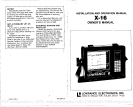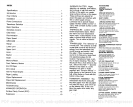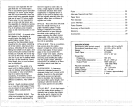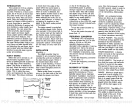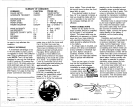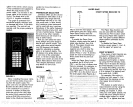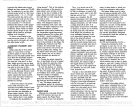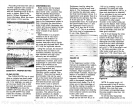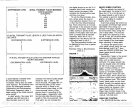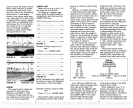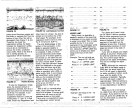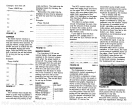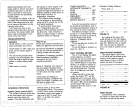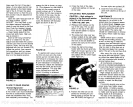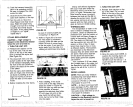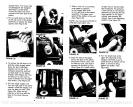
used to outline the bottom contour
which
might
otherwise be hidden
beneath trees and
brush;
it can
also
give
clues to the
composition
of the bottom. A hard bottom
returns a
very strong signal
caus-
ing
a wide
gray
line. A
soft,
muddy
or
weedy
bottom returns a weaker
signal
which is
emphasized
with a
narrow
gray
line. Do not advance
the control
too far or it will
gray
line on the
target completely,
showing
no
black,
which makes
the
target
difficult to see.
RANGE
The
range
function utilizes the
keyboard
to select
any range
between
0 and 8000' in 1 foot
increments. Please read this sec-
tion
carefully
to
get
the most out of
the X-16's
range capabilities.
LOWER LIMIT
When
you
first turn on the X-1
6,
the
range
will be 0-60 feet.
To
change
to a
deeper range,
simply press
the desired
depth
on
the
keyboard,
and then
press
the
LOWER LIMIT
key.
NOTE:
Remember,
any depth may
be used as a lower limit
displayed
at the bottom of the chart
paper.
Example: Change range
to
0-256
Press: 2-5 -6- LOWER
LIMIT
Note that the
paper speed
slows
automatically
at this
range setting.
down to a
minimum when
looking
for fish.
However,
it is
helpful
sometimes
to have
longer pulse
width when
resolution is not a concern. When
using
a sonar in
deeper
water,
it is
easier for the unit to detect a
longer pulse coming
back from the
bottom or from fish. This is called
"Probability
of Echo Detection".
The
probability
of the unit
being
able to detect an echo
returning
from
deep
water is diminished
because the further the sound
pulse
has to
travel,
the weaker it
becomes.
By broadening
the
pulse
length,
in
essence,
a
larger signal
is transmitted and it is easier for
the receiver to detect it.
For this
reason,
the micro-com-
puter
in the X-1 6
automatically
increases the initial
pulse length
of
the unit as
deeper
lower limits are
set
by
the
operator. (Note:
Initial
pulse length
is the
pulse length
of
the unit when the
Suppressor
control is set to
minimum.)
From 200 feet to 599
feet,
the
initial
pulse length
increases at the
same rate as the
depth.
For
example,
with the LOWER LIMIT
set to 260
feet,
the initial transmit
pulse length
would be 260
p5.
If
the LOWER LIMIT is set to 390
feet,
the
initial transmit
pulse
would be 390
ps.
The
pulse
length
from 600
-
879
feet is the
depth plus
4 micro-seconds
Qis)
per
foot OVER 600 feet. In other
words,
with a lower limit of 700
feet,
the initial transmit
pulse
length
would be 1100 micro-
seconds.
The transmit
pulse length
can
be increased from the initial
point
at
any
time
by using
the
Suppressor
control. The maximum
amount
of
pulse length
added to
the initial transmitter
pulse length
is
approximately
800 micro-
seconds. In other
words,
if the
LOWER LIMIT is set
to 420
feet,
and the
Suppressor
control is
increased to the
maximum, (press
7
-
2nd
-
9)
the transmitter
pulse
length
would be 1220 micro-
seconds.
(420
initial + 800
=
1220.)
The amount that the initial
transmit
pulse length
is increased
with
suppression
is listed in the
following
chart.
Remember,
the
number in
the
right
hand column
is the amount added to the initial
transmit
pulse length.
When
Suppressor
level 0" is
chosen,
the
suppressor
level is
automatic. This ties in with the
Discrimination feature. As different
levels of Discrimination are
selected,
and the
Suppressor
level
is set to
0",
the
suppression
level
—
12.0—
120—
—240
-
—240-—-
—360—--———-
—
260—
—400--——
——480—
feet.
—
60.OFT—— 3=1—-—— LOIJRAMCE
- - -
60.OFT
FIGURE 11
Example: Change range
to 0-75
Press: 7
-
5
-
LOWER LIMIT
FIGURE 9
—15.0—--— _——-—
15.0—
—
30.0
-
________—---—
30.0——
45.0 - —
——-—450
600——-—
——--—-— —
—600
—75 OFT
—
111
— —— —
LD4RFMCE——-— 75 OFT
FIGURE 12
FIGURE 10
GRAYLINE "ON"
INITIAL
LOWER TRANSMIT
LIMIT PULSE WIDTH
(feet) (micro-seconds)
1-19 110
20-29 130
30-199
160
200
-
599 Same as LOWER LIMIT
600
-
879 Same as
LOWER
LIMIT +
4ps/ft
over 600'
880
-
maximum
1700
j.s
feet.
8
21
PDF compression, OCR, web-optimization with CVISION's PdfCompressor



